多元概率密度
Humans have plenty of cognitive strengths, but one area that most of us struggle with is estimating, explaining and preparing for improbable events. This theme underpins two of Nassim Taleb’s major works: Fooled by Randomness and The Black Swan: The Impact of the Highly Improbable. In the latter work, Taleb defines a black swan events as having three characteristics: the event is a surprise (to the observer), it has a major effect, and people incorrectly try to rationalize it in hindsight (emphasis mine).
人類具有大量的認知能力,但是我們大多數人都在努力的領域之一是估計,解釋和為不可能的事件做準備。 這個主題奠定了納西姆·塔萊布 ( Nassim Taleb )的兩部主要作品的基礎: 愚弄隨機和《黑天鵝:高度不可能的影響》 。 在后者的工作中,塔萊布將黑天鵝事件定義為具有三個特征:(對觀察者而言)該事件是一個意外事件,具有重大影響,并且人們事后錯誤地嘗試將其合理化 (強調我的觀點 )。
Taleb focuses on black swan events on the world stage, such as the creation of the internet, World War I, and the dissolution of the Soviet Union. I believe that humans behave similarly, and to their detriment, with less unlikely events predicted by statistical models as long as they’re important. We’ve seen this recently in the results of the 2016 presidential election results. Models published by The Huffington Post, The New York Times, and 538 all had Hillary Clinton at a 71–98% chance of winning. After she lost the election, a common reaction was whether we could trust polls [and the models that rely on their data] again, which I was surprise to see even from statistically minded friends. Why is our gut reaction to scrutinize the model that said Trump had a 29% chance of winning? We wouldn’t question the fairness of a coin that comes up tails twice (25% chance) or a 1 of a rolled die (17% chance); both of which are lower than the odds given to Trump winning the 2016 election.
塔萊布(Taleb)專注于世界舞臺上的黑天鵝事件,例如互聯網的創建,第一次世界大戰和蘇聯解體。 我相信人類的行為類似,并且對他們有害,只要它們很重要,統計模型就可以預測不太可能發生的事件。 我們最近在2016年總統選舉結果中看到了這一點。 《赫芬頓郵報》 , 《紐約時報》和538發表的模型都以希拉里·克林頓的獲勝機率達71–98%。 在她失去選舉后,一個普遍的React是我們是否可以再次信任民意測驗(以及依賴于他們數據的模型),即使是從統計學角度看的朋友,我也感到驚訝。 為什么我們的直覺會仔細審查表示特朗普有29%獲勝機會的模型? 我們不會質疑兩次出現尾巴的硬幣的公平性(25%的機率)或一枚擲骰子的硬幣的公平性(17%的機率); 兩者都低于特朗普贏得2016年大選的機會。
I posit that this reaction, which is a form of rationalization by hindsight, is due to the lack of a mental framework to grapple with real world event probabilities, and that not having this framework can result in irrational decision-making. In order to illustrate this, let’s move away from the world of election modeling to a more common situation encountered in the business world.
我認為,這種React是事后回想的一種合理化形式,是由于缺乏解決現實世界事件概率的心理框架,而沒有這個框架會導致非理性的決策。 為了說明這一點,讓我們從選舉建模的世界轉移到商業世界中遇到的更常見的情況。
最黑暗的時間表 (The darkest timeline)
Imagine you’re a data scientist who models the probability of closing sales with potential clients at a business-to-business tech company. Your company is in the process of courting a particularly large client, Megacorp, and so the CEO checks your model every day to track the odds of closing the sale.
想象一下,您是一位數據科學家,他對企業對企業技術公司與潛在客戶達成銷售的可能性進行建模。 您的公司正在尋求一個特別大的客戶Megacorp,因此CEO每天都要檢查您的模型以跟蹤完成交易的幾率。
Thursday: 98% of closing sale
星期四 :收盤價的98%
Incredible news! Whatever your teammates are doing looks like it’s working.
令人難以置信的消息! 無論您的隊友在做什么,都看起來很正常。
Friday: 99% of closing sale
星期五 :成交價的99%
Even better! The CEO starts planning the changes he’ll need to make to your business after the anticipated windfall. Hire more employees? Acquire a competitor? Buy a superbowl ad?
更好! 首席執行官開始計劃在預期的意外收獲后需要對您的業務進行的更改。 雇用更多員工? 收購競爭對手? 購買超級碗廣告?
Monday: 0% of closing sale
星期一 :收盤價的0%
What happened?! You learn that the prospective client chose to go with a competitor at the last minute. This is a huge blow to everybody’s morale, and the time and energy the CEO spent dreaming about expansion after the sale he thought was practically guaranteed was wasted.
發生了什么?! 您了解到,潛在客戶在最后一刻選擇了與競爭對手同行。 這對每個人的士氣都造成了巨大的打擊,而CEO認為夢想中的擴張實際上浪費了很多時間和精力。
What’s a common reaction to this fiasco? “The model must be wrong!” the CEO declares during the postmortem meeting he calls with you. “We should have known that this wasn’t as likely as you said it was. I don’t want to hear from you until it’s fixed.”
對這場慘敗的普遍React是什么? “模型一定是錯誤的!” CEO在事后會議上宣布與您通話。 “我們應該知道,這種可能性不如您所說的那樣大。 在解決問題之前,我不希望收到您的來信。”
產生問題 (Creating a problem)
It’s possible that the CEO is correct. Your model could have predicted a lower chance of closing the sale that your company didn’t end up getting. However, it’s also possible that the model is fine. Your company had a very high chance of closing that sale, but the unlikely happened, and you just didn’t get it.
CEO可能是正確的。 您的模型可能會預測完成您的公司最終沒有獲得的銷售的機會較低。 但是,該模型也可能很好。 貴公司有很高的機會完成那筆交易,但是發生的可能性很小,而您卻沒有得到。
You are now in an uncomfortable position. It’s possible that the only way of “improving” the model, is to produce one that estimates lower odds of closing the Megacorp sale at the expense of modeling future sales accurately. This is called overfitting. By complying with your CEO’s request in order to stay in his good graces, you’re doing damage to your model — and the company — by distorting predictions of future sales.
您現在處于不舒服的位置。 “改善”模型的唯一方法可能是產生一種估計Megacorp銷售的較低賠率的方法,而以準確建模未來銷售為代價 。 這稱為過擬合 。 通過遵守CEO的要求以保持他的良好風度,您正在歪曲對未來銷售的預測,從而損害了您的模型以及整個公司。
回歸本源 (Back to basics)
Before we get to my proposed mental framework that can help folks better understand complex, real world event probabilities, let’s start with a simple example. Imagine you have a fair six sided die. You roll the die over and over and start recording results. After many rolls, you observe what you’d expect: around the same number of rolls come up with each number, one through six.
在我們提出可以幫助人們更好地理解復雜的,現實世界中的事件概率的心理框架之前,讓我們從一個簡單的示例開始。 想象您有一個公平的六面模。 您將骰子一遍又一遍地滾動并開始記錄結果。 經過多次擲骰后,您會觀察到期望的結果:每個號碼都會出現相同數目的擲骰,從一到六。
After a few hundred rolls, you get an unlikely, and unlucky (in most games) streak. A 1, followed by another 1, followed by another 1! The odds of this happening are 1/216 = ~0.5%. This is an unlikely event. Are you surprised? Do you doubt the fairness of the die? Do you tell the die it better fix itself before you roll it again?
經過幾百次擲骰后,您會獲得不太可能的,不幸的(在大多數游戲中)連勝紀錄。 一個1,然后是另一個1,然后是另一個1! 發生這種情況的幾率是1/216 =?0.5%。 這是不太可能發生的事件。 你驚喜嗎? 您是否懷疑死亡的公平性? 您是否告訴模子在再次滾動之前更好地自我修復?
Most people, even those without any statistical training, would say no. What happened was unlikely, but the die was behaving as expected otherwise. Additionally, if we think hard enough about it, we can explain the mechanism behind the randomness of the die rolls. Once the die leaves your hand, it is subject to the laws of physics, and is entirely predictable. The reason die throws are random is that slight changes in the velocity and orientation immediately after release result in different outcomes. Nobody has the fine motor skills necessary to cheat at die rolling, which would allow them to let some numbers appear more frequently than others.
大多數人,甚至沒有經過統計學培訓的人也會拒絕。 發生的事情不太可能發生,但是死亡的行為與預期相反。 此外,如果我們認真考慮一下,就可以解釋模頭輥隨機性背后的機理。 一旦模具離開您的手,它就受物理定律的約束,并且完全可以預測。 擲骰子是隨機的,原因是釋放后立即改變速度和方向會導致不同的結果。 沒有人具有在壓鑄時作弊的必要的高級運動技能,這會使他們讓某些數字比其他數字更頻繁地出現。
We can use the idea of statistical populations, which are “a set of similar items or events which is of interest for some question or experiment” (Wikipedia). In this case, the items of interest are die rolls. As velocity and orientation vary, we get different outcomes.
我們可以使用統計種群的概念,即“一些問題或實驗都感興趣的一組相似的項目或事件”( 維基百科 )。 在這種情況下,感興趣的項目是模具卷。 隨著速度和方向的變化,我們得到不同的結果。
When we roll the die, what we’re doing is sampling from this population. The population of all possible throws (even the ones where the die drops out of your hand or is hurled out of an open window) contains equal shares of each outcome. If we think of this in terms of area, as is shown in the diagram above, we can imagine that the population has equal areas for each outcome, one through six.
當我們擲骰子時,我們正在做的是從這個總體中采樣。 所有可能的擲出的總數(甚至是骰子掉落到您手中或被擲出一個打開的窗口的那些擲出)所包含的每個結果的份額相等。 如上圖所示,如果我們以面積為單位來考慮這一點,我們可以想象每個結果中的人口具有相等的面積,從1到6。
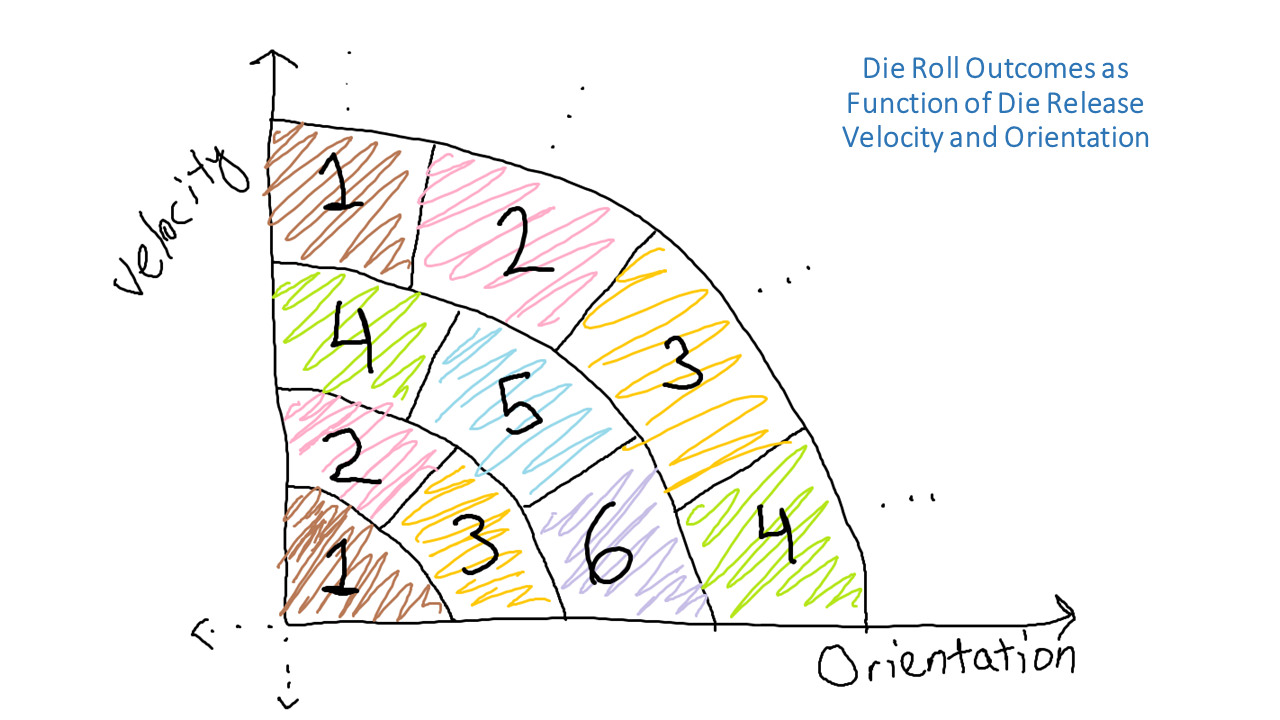
Before we add some complexity, I want to reinforce the idea that although there are only six equally likely die roll outcomes, there are infinite combinations of velocity and orientation, which when obeying the unchanging laws of physics, result in those outcomes. We can imagine doing two distinct types of work with this strong understanding of die rolling:
在我們增加一些復雜性之前,我想強調一下這樣的觀點:盡管只有六個同樣可能的擲骰結果,但速度和方向有無限的組合,當遵循物理不變的定律時,會導致這些結果。 我們可以想象在對壓鑄有深入了解的情況下進行兩種截然不同的工作:
We can use our understanding of the equally weighted population outcomes to come up with optimal strategies in different areas such as games, gambling, and business.
我們可以使用對加權平均結果的理解來提出不同領域(例如游戲,賭博和商業)的最佳策略。
We could try to use our understanding of the mechanism driving the equal probabilities, namely that the velocity and orientation of the die after release can perfectly predict its outcome, to try to get certain outcomes to happen more frequently. A human couldn’t do this, but perhaps we could create a robot that can throw a die that results in 6s every time.
我們可以嘗試使用對驅動相等概率的機制的理解,即釋放后模具的速度和方向可以完美地預測其結果,從而嘗試使某些結果更頻繁地發生。 人類無法做到這一點,但是也許我們可以創造一個可以擲出骰子的機器人,每次導致6s的死亡。
增加復雜性 (Adding back complexity)
What’s the statistical population in our sales example? Most folks would answer that it’s all possible sales clients. I’ve always found something frustrating with this definition: we can’t use it to explain why our model returns a 99% chance of landing the sale that we didn’t get without admitting that it must be model error. If that’s the case, our CEO — who is not an expert in probability and statistics— feels justified in his request.
我們的銷售示例中的統計人口是多少? 大多數人會回答這是所有可能的銷售客戶。 我總是對這個定義感到沮喪:我們不能用它來解釋為什么我們的模型在沒有承認一定是模型錯誤的情況下獲得了99%的機會獲得了我們沒有得到的銷售。 如果是這樣,我們的首席執行官(不是概率和統計專家)會覺得有道理。
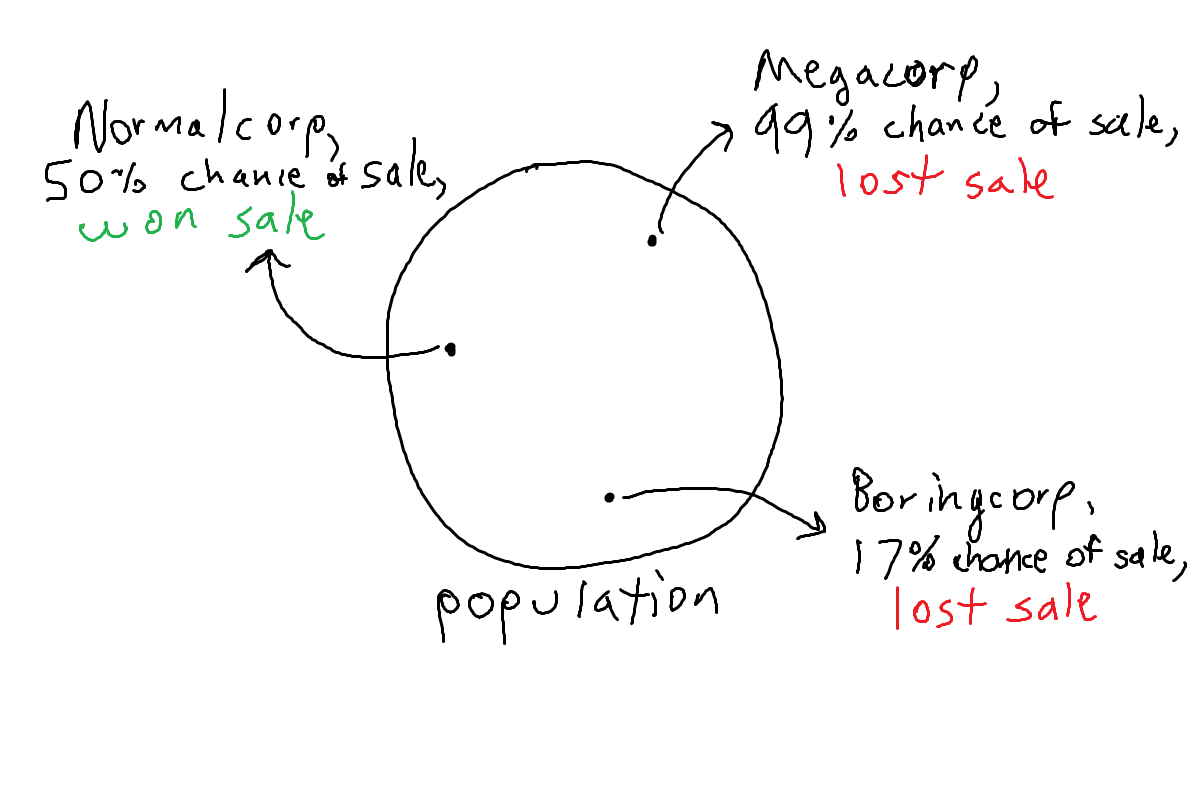
One way we could address this is to group predictions together in accuracy buckets (e.g. 0–10%, 10–20%, … 90–100%) and chart their accuracies jointly. A well performing model will show that these predictions behave around what’s observed in aggregate.
我們可以解決這個問題的一種方法是將預測合并到準確度組中(例如0–10%,10–20%,…90–100%),并共同繪制其準確性。 表現良好的模型將表明,這些預測與總體觀察到的結果一致。
This still doesn’t satisfy my need to understand that predicted 99%. Imagine that in aggregate, we predict 96% of the sales in the 90–100% predicted bucket to be closed, but only 95% are. One could still argue that by fixing the model, and bringing down our predicted 99%, we still improve this aggregate accuracy.
這仍然不能滿足我對99%預測值的理解。 想象一下,總體而言,我們預計90-100%的預測存儲段中的96%的銷售將關閉,但只有95%的交易將關閉。 仍然可以說,通過修復模型并降低我們的預測99%,我們仍然可以提高這一總體準確性。
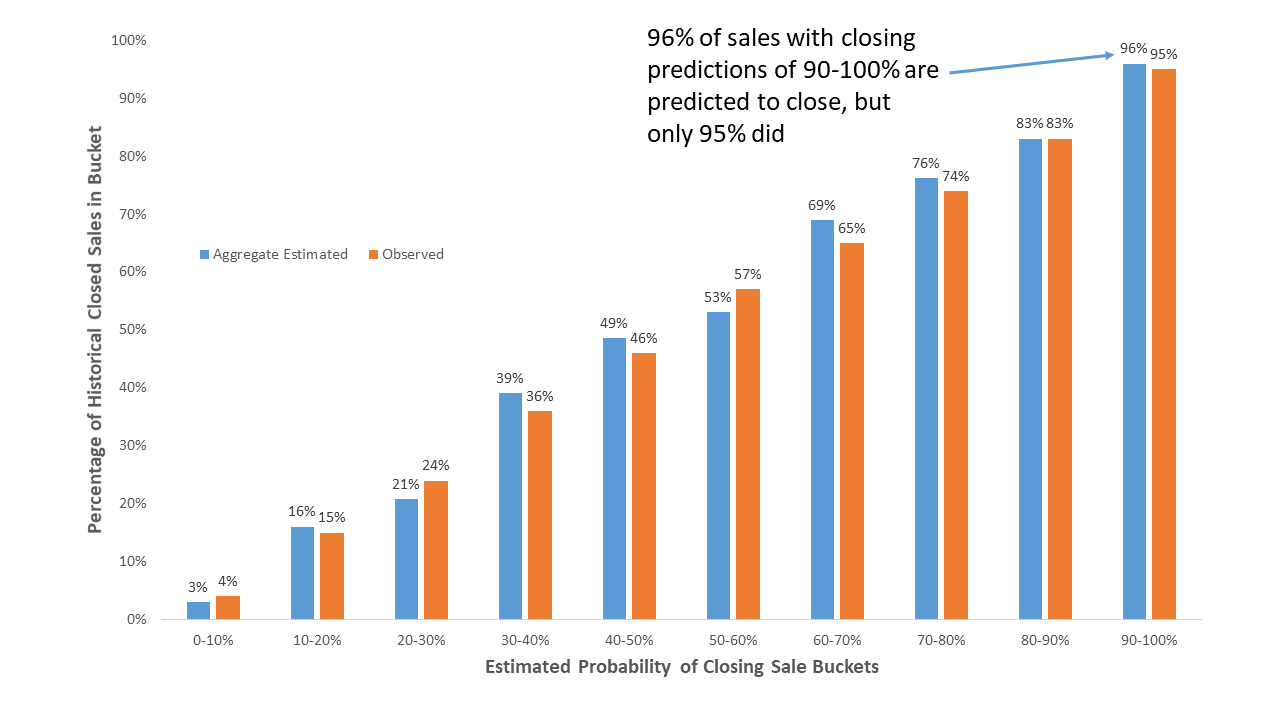
Unlike in the die rolling example, we can’t easily resample from the population. We can’t relive history, pitching Megacorp 100 times in 100 slightly different ways and land that sale 99 out of those 100 times. But we can imagine doing so with multiverse theory! In multiverse theory, specifically Level III: The Many-Worlds Interpretation, all possible outcomes of probabilistic events happen in some universe and do so in proportion to their probabilities. I’d like to define a multiverse population as the statistical populations (in this example: all potential clients) in all possible universes. Expanding upon the statistical population example above, we can turn every dot, which represented each potential client, into a circle which represents that potential client’s outcomes in all universes. The higher the likelihood of winning that client’s business, the greater the proportion of universes in which their business is won, and therefore the larger the area in the client circle. Note that if I shaded in the entire multiverse population, it would resemble the die rolling diagram I shared earlier.
與模版滾動示例不同,我們無法輕松地從總體中重新采樣。 我們無法重溫歷史,以100種略有不同的方式向Megacorp推銷100次,并在這100次中售出99次。 但是我們可以想象用多元宇宙理論來做到這一點! 在多元宇宙理論中 ,特別是在第III層級:“多世界解釋”中 ,概率事件的所有可能結果都發生在某個宇宙中,并且與它們的概率成比例地發生。 我想將多宇宙人口定義為所有可能宇宙中的統計人口(在本例中為所有潛在客戶) 。 擴展上面的統計總體示例,我們可以將代表每個潛在客戶的每個點變成一個圓圈,該圓圈代表所有宇宙中該潛在客戶的結果。 贏得該客戶的業務的可能性越高,贏得其業務的Universe的比例就越大,因此客戶圈子的面積越大。 請注意,如果我在整個多宇宙總體中進行陰影處理,則它將類似于我之前共享的模具滾動圖。
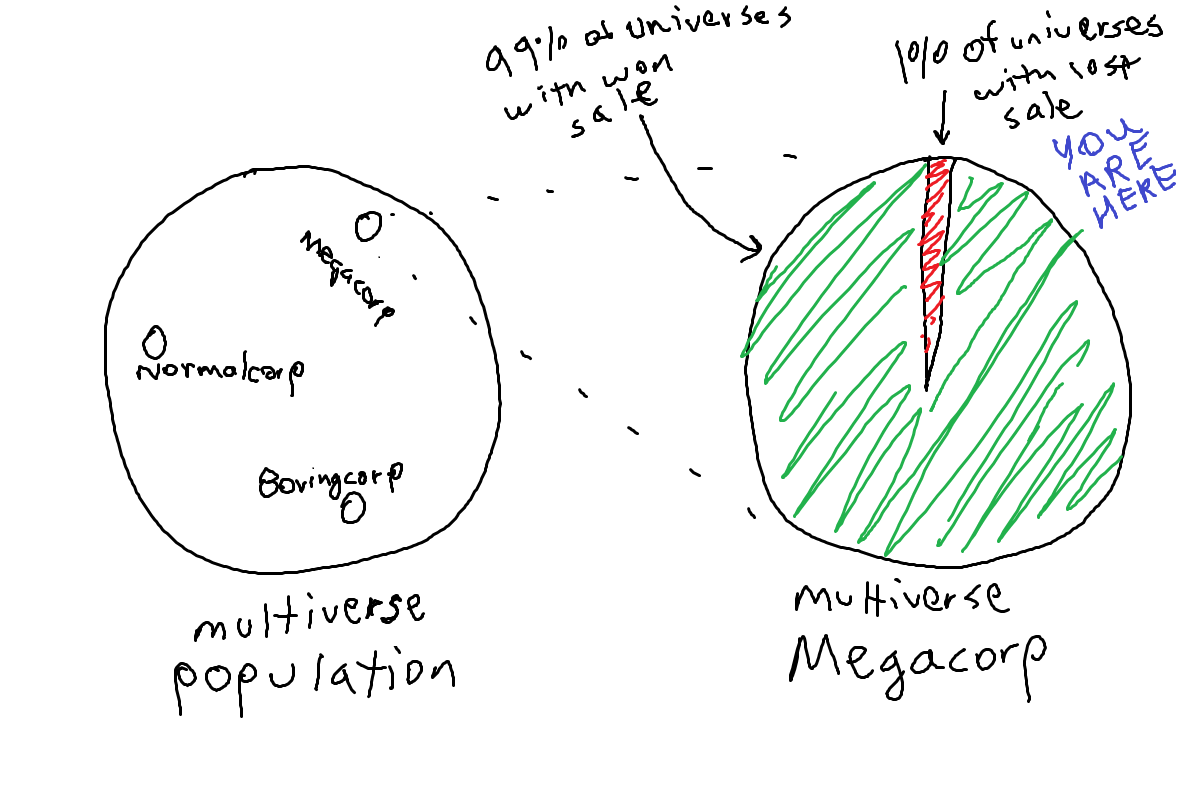
擁有多元宇宙心理框架的好處 (Benefits of having a multiverse mental framework)
Astute readers have noticed that we cannot use this multiverse approach to probabilities to prove that our model is correct. We can’t hop from universe to universe, tabulating the proportion in which we win the Megacorp sale to show our CEO that our model is working as intended. In fact, it’s impossible to show that any model perfectly explains the world. The best we can do is to know that a model reasonably predicts samples from our population of interest, often by contrasting it with other, less accurate models. Even then, we still rely on assumptions to do so, one of the most important of which is that the systems does not undergo unanticipated structural changes. All of our predictions will be off if such a change happens. In our example, a strong competitor entering or leaving the market would represent such a change.
精明的讀者已經注意到,我們不能使用這種多元方法來證明我們的模型是正確的。 我們無法在宇宙之間跳來跳去,列出贏得Megacorp交易的比例以向我們的CEO展示我們的模型正在按預期工作。 實際上,不可能顯示出任何模型都能完美地解釋世界。 我們能做的最好的事情就是知道一個模型可以合理地從我們感興趣的人群中預測樣本,通常是將其與其他不太準確的模型進行對比。 即使到那時,我們仍然要依靠假設來做到這一點,其中最重要的一項是系統不會發生意外的結構變化。 如果發生這種變化,我們所有的預測都將失效。 在我們的示例中,強大的競爭者進入或退出市場將代表這種變化。
In my experience, many data scientists ignore or even dismiss non-empiric ideas such as this multiverse theory approach to grappling with probabilities, but they are doing so at their own peril. The first benefit of using the theory is that it is an accessible way of explaining probabilities to those who don’t have a strong background in them, like the CEO in our example. It’s possible that explaining your model outputs using multiverse theory helps consumers of your models become more comfortable with how to interpret them. It can be done on its own or addition to a short explanation on overfitting to persuade our hypothetical CEO to drop his (potentially) irrational demand to tweak your model until it brings down the Megacorp sale probability.
以我的經驗,許多數據科學家會忽略甚至忽略非經驗性的想法,例如這種采用多元理論來解決概率問題的方法,但這樣做的后果自負。 使用該理論的第一個好處是,它是一種向那些沒有較深背景的人(例如我們的示例中的CEO)解釋概率的一種可訪問的方法。 使用多元宇宙理論解釋模型的輸出可能會幫助模型的使用者對如何解釋它們感到更自在。 它可以單獨完成,也可以在簡短說明中補充說服力,以說服我們假設的首席執行官放棄(可能)不合理的需求來調整您的模型,直到降低Megacorp的銷售概率。
The second benefit is that the multiverse theory approach to interpreting probabilities is that it gives us a useful structure for what-if analyses. Remember the mechanism for randomness in our die rolling example? I shared that the reason a fair die comes up with each outcome in the same proportion is because small changes — smaller than we can control with our fine motor skills — result in different outcomes. We can show that using a little more force or a different orientation turns a throw that would result in a 1 into one that results in a 2. Unfortunately, business outcomes cannot be predicted perfectly by a system as consistent as classical mechanics. However, we can try to imagine what we could have done differently to increase our chances of closing the Megacorp sale and use it to help with future ones. People do this all the time when they do what-if analyses: one can imagine the CEO thinking “if only I had answered Megacorp’s questions about our service personally” or “I wonder what would have happened if we gave them a discount because they’d be an impressive client to have.” We need to understand that neither of these actions guarantees the sale, but they can increase its odds, and applying the multiverse theory we can imagine flipping universes in which the sale is not made to ones in which it is. In the below diagram, I demonstrate what this would look like for the Normalcorp client, which originally has a 50% chance of sale, as increases from 50% are easier to see.
第二個好處是,用于解釋概率的多元宇宙理論方法為我們提供了一種假設分析的有用結構。 還記得我們的擲骰示例中的隨機性機制嗎? 我分享了每個結果以相同比例出現的原因是因為微小的變化(小于我們可以用自己的精細運動技能控制的變化)導致不同的結果。 我們可以證明,使用更多的力或使用不同的方向可以將導致1的擲變成2的擲。不幸的是,系統無法像傳統力學一樣完美地預測業務結果。 但是,我們可以嘗試想象我們可以做些什么來增加我們完成Megacorp交易的機會,并用它來幫助將來的交易。 人們總是在做假設分析時一直這樣做:人們可以想象CEO在思考“如果只有我親自回答了Megacorp關于我們服務的問題”或“我想知道如果我們給他們折扣,會發生什么,因為他們成為令人印象深刻的客戶。” 我們需要了解的是,這些行為都不能保證銷售,但是它們可以增加銷售的幾率,而運用多元宇宙理論,我們可以想象將沒有進行銷售的宇宙翻轉為進行銷售的宇宙。 在下圖中,我演示了Normalcorp客戶的情況,該客戶最初有50%的銷售機會,因為從50%的增長很容易看到。
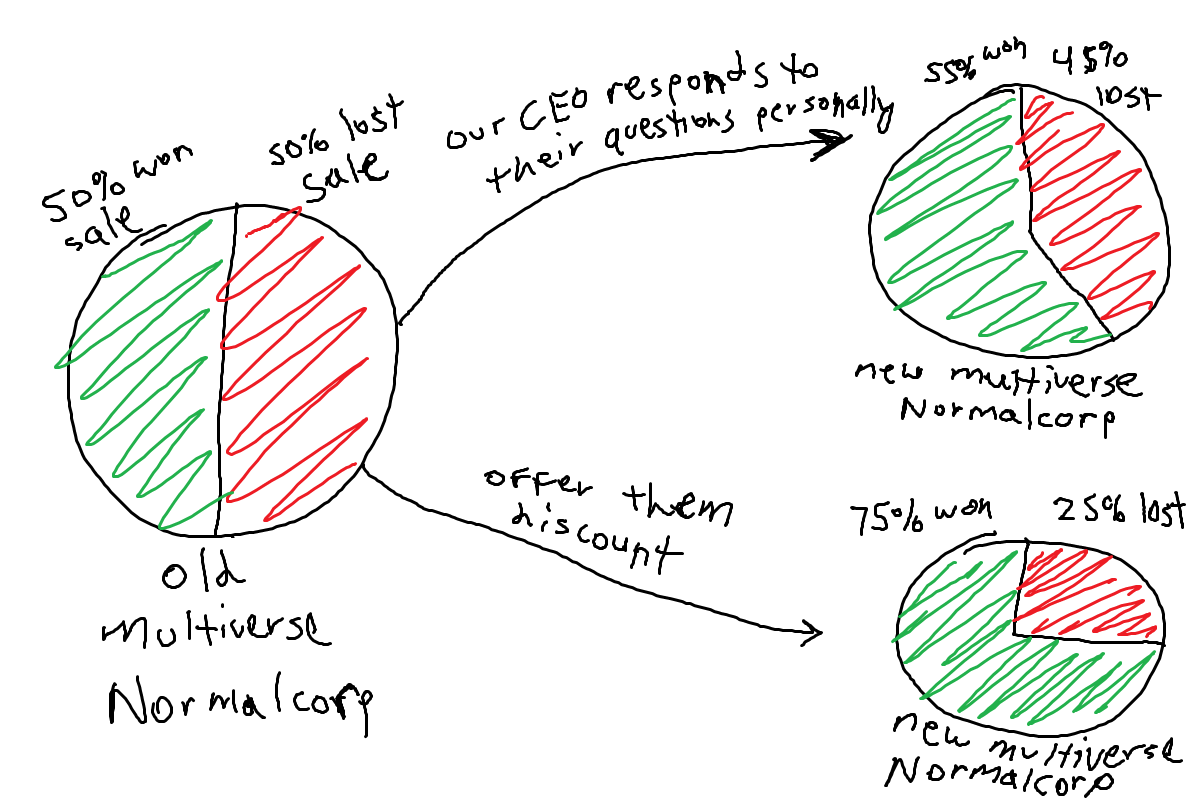
I hope that viewing event probabilities using multiverse theory helps close the gap between understanding simple probabilities often used in stats courses (e.g. flipping coins, rolling dice, or pulling cards out a deck) and complex ones in the real world (e.g. probability of closing a sale, likelihood of converting a user to a paid subscription plan). For some fun explorations of thinking about probabilities through multiverses, I’d recommend the Remedial Chaos Theory episode (and subsequent ones that reference it) of Community, in which a die roll creates multiple timelines, and all of Rick and Morty. Try it out for yourself, share and discuss the idea with others — including me, I’ll do my best to respond to comments here or on Twitter, and see if it helps makes sense of complex real world phenomena and enables more rational decision-making.
我希望使用多元宇宙論來查看事件概率有助于縮小理解統計課程中經常使用的簡單概率(例如,擲硬幣,擲骰子或從牌組中抽出卡)與現實世界中復雜的概率(例如,關閉概率)之間的差距。銷售,將用戶轉換為付費訂閱計劃的可能性)。 對于通過多元宇宙思考概率的一些有趣的探索,我建議使用“社區的補救混沌理論”一集(以及隨后的參考書集) ,其中擲骰創建多個時間軸,以及所有Rick和Morty 。 親自嘗試一下,與他人分享并討論這個想法-包括我在內,我將盡力在此處或在Twitter上回應評論,看看它是否有助于理解現實世界中的復雜現象并做出更合理的決策-制造。
翻譯自: https://towardsdatascience.com/grappling-with-event-probabilities-using-multiverse-theory-26b46067da14
多元概率密度
本文來自互聯網用戶投稿,該文觀點僅代表作者本人,不代表本站立場。本站僅提供信息存儲空間服務,不擁有所有權,不承擔相關法律責任。 如若轉載,請注明出處:http://www.pswp.cn/news/392301.shtml 繁體地址,請注明出處:http://hk.pswp.cn/news/392301.shtml 英文地址,請注明出處:http://en.pswp.cn/news/392301.shtml
如若內容造成侵權/違法違規/事實不符,請聯系多彩編程網進行投訴反饋email:809451989@qq.com,一經查實,立即刪除!

)




)






)
![[Object-C語言隨筆之三] 類的創建和實例化以及函數的添加和調用!](http://pic.xiahunao.cn/[Object-C語言隨筆之三] 類的創建和實例化以及函數的添加和調用!)



)